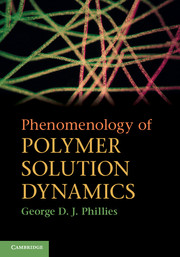Book contents
- Frontmatter
- Contents
- Preface
- 1 Introduction
- 2 Sedimentation
- 3 Electrophoresis
- 4 Quasielastic light scattering and diffusion
- 5 Solvent and small-molecule motion
- 6 Segmental diffusion
- 7 Dielectric relaxation and chain dimensions
- 8 Self- and tracer diffusion
- 9 Probe diffusion
- 10 Dynamics of colloids
- 11 The dynamic structure factor
- 12 Viscosity
- 13 Viscoelasticity
- 14 Nonlinear viscoelastic phenomena
- 15 Qualitative summary
- 16 Phenomenology
- 17 Afterword: hydrodynamic scaling model for polymer dynamics
- Index
- References
16 - Phenomenology
Published online by Cambridge University Press: 05 August 2012
- Frontmatter
- Contents
- Preface
- 1 Introduction
- 2 Sedimentation
- 3 Electrophoresis
- 4 Quasielastic light scattering and diffusion
- 5 Solvent and small-molecule motion
- 6 Segmental diffusion
- 7 Dielectric relaxation and chain dimensions
- 8 Self- and tracer diffusion
- 9 Probe diffusion
- 10 Dynamics of colloids
- 11 The dynamic structure factor
- 12 Viscosity
- 13 Viscoelasticity
- 14 Nonlinear viscoelastic phenomena
- 15 Qualitative summary
- 16 Phenomenology
- 17 Afterword: hydrodynamic scaling model for polymer dynamics
- Index
- References
Summary
Introduction
In previous chapters, a range of experiments on aspects of polymer solution dynamics, from electrophoretic mobility to single-chain diffusion to linear viscoelasticity, has been treated(1). The previous chapter described results that were found with each method. What do these types of measurement tell us about how polymer molecules move through solution? The answers to this question come in a substantial number of parts and pieces, best treated separately before being assembled into final conclusions. There are undoubtedly other parts and pieces that might have been discussed, such as the consequences of changing the relative size of matrix and probe polymers, or the consequences of polymer topology. This chapter stays with answers most central to our purpose.
Comparison with scaling and exponential models
We began in Section 1.2 by observing that the large number of theoretical models could with a modest number of exceptions be partitioned into two major phenomenological classes, based on whether themodels predicted scaling (power-law) or exponential dependences of transport coefficients on polymer concentration, molecular weight, or other properties. What do the data say about the relative merit of these classes of theoretical model?
An obvious first question is whether the precision of experimental measurement, as viewed through the lens of our data analysis methods, is adequate to say whichmodels are acceptable. Can we distinguish between power laws and stretched exponentials? The answer is unambiguously in the affirmative.
- Type
- Chapter
- Information
- Phenomenology of Polymer Solution Dynamics , pp. 475 - 493Publisher: Cambridge University PressPrint publication year: 2011



